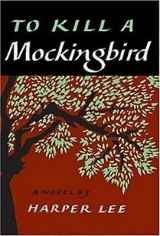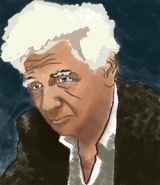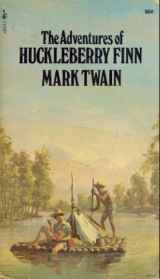Derrida in Twain: Deconstructing Racism in American Literature
An African American, a Hispanic American, a White American, and an Innocent Child are sitting in a room when a white elephant walks in waving a Nazi flag. The Innocent Child points and says, “Elephant!” The three adults immediately scold the child, “Don’t talk about the elephant!” Tired, ridiculous analogy? Maybe. But are we doing exactly this same ridiculous act every day? As a society, we cannot hope to eliminate racism until we discuss not tolerance but rather understand and deconstruct the racism within us all.
Here is a less ridiculous example than our Fascist pachyderm. An African American couple moves into an all-white neighborhood. The elderly lady next door immediately goes to welcome them. Central to her conversation are several dozen people she knows, has worked for, or respects who are also African American. She leaves them with an offer to help them any way she can. Are they likely to call her? Is she racist? Perhaps her intentions are good; she has not taken any overt act of racism. This woman has done nothing more than the innocent child: She has acknowledged the issue but not understood it.

This very type of racism is, in fact, central to Cassie Dandridge Selleck’s Pulitzer Prize winning novel The Pecan Man. The main character, Mrs. Beckworth, is shocked several times by overt racism in her community (Selleck). Meanwhile, she is always respectful to her African American maid, Blanche, counting her as a friend and even donating exclusively to charities Blanche frequents (Selleck). When Blanche takes offense at special help offered to her, Mrs. Beckworth is taken aback. Mrs. Beckworth finally reaches her epiphany when, after decades, she tells Blanche she does not need to wear the uniform of her office (Selleck). This act is significant as a parallel to head scarves worn by former slaves. Mrs. Beckworth realizes “I had confused social graces with a social conscience” (Selleck). Selleck paints a powerful message echoed by many researchers that racism today is simply more covert, not gone (Pennington 94).
Racism in America doesn’t take such overt stances in most cases as my first example. When people express these opinions openly, we ostracize like the three adults. This takes the form of censorship—either societal or internal (Reinelt 3). This has also closed dialogue necessary to understand the issue. Eliminating open racism has not resulted in people that are more tolerant but rather a “new racism” (Pennington 94). “Political correctness” drives these ideas deeper into the unconscious but cannot eliminate the opinions (Reinelt 3). This can manifest in frustration towards programs such as affirmative action (Pennington 94), more subtly in unconscious stereotypes (Ghoshal, et al. 130), or even in the good intentions of an old woman (Selleck). Some researchers believe that whites even begin to move the blame for racism to members of the minority group (Burley 118). This stems from mistaken beliefs (especially among whites) that racism in America does not exist, or has become “reverse discrimination” by favoring previously oppressed groups (Burley 117).

Another excellent literary example of this “new racism” is Harper Lee’s classic (also a Pulitzer Prize winner) To Kill a Mockingbird. Racism is a driving force in this novel, but not the only issue under discussion. Recent events in the news (the Ferguson and Trayvon Martin shootings) make the messages as relevant today as in the 1960’s. Racial tensions drive justice as much today as they do in Lee’s novel. It is clear that, while we may pride ourselves as a more tolerant society that does not have the lynch mobs like the one Atticus stops (Lee 152), all society has done is put a bandage on a festering abscess.
Atticus instructs Scout on racism many times. “You’ll see white men cheat black men every day. . . no matter who he is. . . that white man is trash” (Lee 252). Atticus clearly understands overt racism. On the other hand, he also knows “you never really understand a person . . . until you climb into his skin and walk around in it” (Lee 33). This statement is heavy with meaning. The use of the word “skin” clearly echoes race while the image of wearing someone else’s skin, in a literal sense, forms a paradox. That is, we cannot understand someone unless we wear their skin, but we cannot wear their skin, so we cannot understand them, which leads us to better understanding itself.
Atticus is clearly a well-intentioned man and perhaps even a good man, but we do not know how he arrived at this relatively tolerant outlook because Scout is a particularly unreliable narrator (due to her age). Lee hints that Atticus has grown to this point using birds as a symbol. “Mockingbirds don’t do one thing but make music for us to enjoy. . . . That’s why it’s a sin to kill a mockingbird” (Lee 103). Neither Lee nor Atticus ever directly applies this statement to the African Americans in the novel; however, it is an implied comparison highlighting a hidden racism. If applied to African Americans, the belief that they exist solely to make white people’s lives easier is an example of “new racism.” We find later that, while Atticus views killing a mockingbird as a sin, he used to bring home over a dozen doves when he was out shooting as a younger man (Lee 112). Doves also cause no particular damage. If we apply this to racism (as Lee implies with Atticus’ “unfair advantage” [Lee 112]), we see Atticus has become tolerant only by understanding his previous tendencies to racism. The key to this and most tolerance is that, “the one thing that doesn’t abide by majority rule is a person’s conscience” (Lee 120).
Our modern society has turned back towards a logocentric ideal of this word “racism.” If we view this concept in light of Saussure’s philosophy, there can be no concrete perception of racism (“Différence” 285). All concepts, all signs, are arbitrary and defined only in relation to other signs (“Différence” 285). Humans define the world as binary sets of concepts (a concept of darkness necessitates a concept of light), or on a scale (the concept of a mansion is only understandable as different from a shack, hovel, or trailer). If this is true, there is no functional difference between a lynch mob and Mrs. Beckworth aside from where we stand on the scale.
How can we eliminate racism? The writings of Jacques Derrida would suggest humanity is incapable of eliminating racism. Truth in society, as in literature, is only visible when we are able to lose the misconception that words have a concrete meaning (“Of Grammatology” 306). A sign signifies against what is not stated, by the absent contrast. The human need to define the world by a system of differences (“Différence” 286) requires us to use shortcuts of reasoning even when defining people. Attempts to deny these undesirable stereotypes exist leads to a systemic problem we cannot fix since we refuse to admit it exists (Burley 118).

This line of reasoning is not new to a literary theorist. Arbitrary sounds assigned meanings arbitrarily form all human language through concepts or signs (“Différence” 286). A concept cannot explain itself without an absent contrast (“Différence” 285). Therefore, counterintuitively and perhaps perversely, a notion of tolerance necessitates a notion of racism.
Studies consistently show that, although we may never be able to eliminate all racism, we can understand and mitigate the behaviors associated with these unconscious opinions (Ghoshal, et al. 137). Though the variables are by not necessarily causative, there are indications that reduced cognitive ability and prejudice are co-occurring (Hodson and Buseri 193). Increased and equalized contact with members of a different race tends to reduce unconscious racism (Hodson and Buseri 193; Ghoshal, et al. 137; Pennington 118). Above all, education cannot focus solely on pre-Civil War racism patterns without simultaneous investigation of the “new racism” of brought by “political correctness” and misguided attempts at decency (Ghoshal, et al. 138).
We can therefore see that the education must improve both cognition and critical thinking. If we wish to eliminate racism, then we must meet it critically. A sign cannot simply exist in a binary contrast or sliding scale according to Derrida; signs must have movement or existence on two axes (“Différence” 279). The first axis is a spatial differentiation, which Freud might define as the id and ego in this case (“Différence” 279). The second axis is movement and relation to time (which here might be the superego) (“Différence” 279). All signs are constructed, understood, and created in relationship to history and social conventions (“Différence” 286).
If the road to tolerance must truly lead through racism, then we seem to be at an impasse. For the better, overt and heinous acts of racism are rare these days. But racism and tolerance must fall on the same continuum; it is only though the implied existence of one that we can prove the explicit existence of the other. We must therefore not only understand racism but actually study it.
Luckily, but not happily, American literature is full of examples of historically defined racism ranging from overt statements to implied ignorance. Rather than focus on those who attacked racism (such as Hughes and Dunbar), I would like to reiterate the importance of studying and understanding racism itself. Dunbar, Hughes and even Morrison spoke of tolerance, but Mark Twain (for one) talked about racism.

Nowhere is the need for education more clear than in what is arguably the most racist book ever published in America: The Adventures of Huckleberry Finn. Twain uses the “n-word” over two hundred times in this relatively short novel. Many readers balk at that highly offensive word. The book is one of the most banned book in American literature; others recognize it as a masterpiece (TIME). The first banning took place while the presses were still cooling from the first edition (TIME). Twain himself recognized this was not a book for children, but every adult should read this book for one reason: Huck’s failures are society’s failures.
The first appearance of the n-word is in Chapter I: “Miss Watson she kept pecking at me. . . By and by they fetched the n—s in” (Twain, ch. I). The steps in this passage are: Huck receives instruction or admonition, Huck uses a racial slur. Who, then, taught Huck the word? This is further strengthened when Jim is first introduced as “Miss Watson’s n—, Jim” (Twain, ch. IV). This same passage starting with the n-word goes on to call him simply “Jim” seven times (Twain, ch. IV).
Following this, Huck does not say the n-word again until his father rants in Chapter VI about how the government and the n— is causing him problems (the word is used six times by Huck’s father in one paragraph) (Twain). Immediately after this tirade by an adult, Huck’s narrative returns to the n-word. Again, this is a learned behavior and societal failure.
Shortly after this, Huck fakes his own death, frames his father for murder, and does not use the n-word again for nearly three full chapters. Huck’s split from his father brings with it a minor departure from racism symbolic of Huck’s own growing social conscience. Huck returns to this coarse language most often when he must maintain social conventions in conversations with adults, such as his need to cover his tracks in Chapter XVI as men come looking for Jim (Twain).
As we know, Huck and Jim become friends as the book continues. Huck begins to realize he is also an accomplice. Morality aside, helping a slave run away is a crime. Huck battles with his conscience several times, and the n-word shows up as he tries to balance his opinion of Jim against society’s opinions. The heaviest concentration of the n-word begins in Chapter XXXI when Huck is attempting to find an ethical balance between the law—which says he must turn Jim in—and his conscience—which says he cannot (Twain).
We must not censor and deny the racism of our past literature, but embrace it. As teachers of literature, we have a responsibility to ensure that tomorrow’s students are aware of yesterday’s racism. Mark Twain left a nuanced message in Huckleberry Finn similar to Lee and Selleck’s messages in The Pecan Man and To Kill a Mockingbird; acknowledged racism leads to tolerance. Education must teach self-awareness of where we are in this Saussurian scale of racist tendencies. However, we all must be on that scale. We must help our students understand this or we doom them to the new racism of repressed hate that manifests as simple tolerance.
Works Cited
Burley, David. “White Racial Reasoning: Rational Racism in the Perception of White Males.” Humanity and Society 29.2 (2005): 116-24. Web.
Derrida, Jacques. “Différence.” Literary Theory: An Anthology. 2nd ed. Eds. Rivkin, Julie and Michael Ryan. Malden, MA: Blackwell Publishing, 2002. 278-99. Print.
— “Of Grammatology.” Literary Theory: An Anthology. 2nd ed. Eds. Rivkin, Julie and Michael Ryan. Malden, MA: Blackwell Publishing, 2002. 300-31. Print.
Ghoshal, Raj Andrew, Cameron Lippard, Vanesa Ribas, and Ken Muir. “Beyond Bigotry: Teaching about Unconscious Prejudice.” Teaching Sociology 41.2 (2012): 130-43. Web.
Hodson, Gordon, and Michael Busseri. “Bright Minds and Dark Attitudes: Lower Cognitive Ability Predicts Greater Prejudice Through Right-Wing Ideology and Low Intergroup Contact.” Psychological Science 23.2 (2012): 187-95. Web.
Lee, Harper. To Kill a Mockingbird. 1961. New York: Harper Collins Publishing, Inc., 2002. Print.
Pennington, Donald. Social Cognition. Routledge Publishing, 2000. Web.
Reinelt, Janelle. “The Performance of Political Correctness.” Theatre Research International 36.2 (2011): 134-47. Web.
Selleck, Cassie Dandridge. The Pecan Man. 2012. Read by Suzanne Toren. Ashland: Blackstone Audio, 2014. Audio book.
TIME. “The Adventures of Huckleberry Finn.” Los Angeles: Time Magazine, 2008. Web. March 27, 2015.
Twain, Mark. The Adventures of Huckleberry Finn. 1884. David Widger ed. Salt Lake City: Project Gutenberg, 2006. Web.
What do you think? Leave a comment.











It fascinating to think that Mark Twain was not a racist, at a time full of racists.
I think everyone, as stated, is slightly racist. Any criminal justice student knows that all humans identify people better when they are of the same race. Everyone classifies people they see by categorical expectations. This is a necessity that only becomes dangerous if we do not understand it.
The point of this article was not that Twain was tolerant, but that we should evaluate exactly how and where his racism lies in order to draw out our own stereotypes.
Prejudices are unavoidable to a degree, the damage of not just racism but all stereotypes would be easier to evaluate by looking at the damage they cause to better how we as a society look at people.
To KIll a Mocking Bird Is one of the most signifiacant American Novels ever writen, Up there with Tom Sawyer, The Sun Also Rises,and The Grapes of Wrath.
Many people here have pointed out that Twain used “Huckleberry Finn” to point up the idiocy of racism at least towards black people, but interestingly, he really really hated Native Americans! He also loathed James Fennimore Cooper and the “Natty Bumpo” series. Oh, and he hated chiropracters. Twain was a good hater!
Go read some of Jack London’s work. He had no particular issues with blacks, but how he hated the Chinese!
I dig this cat Derrida, reminds me of Duchamp and/or the Dadaists.
Good stuff you won’t really see outside of literary/cultural theory. Also, it is extremely dense. Honestly, I find Supreme Court decisions easier to read.
I had a professor who had a legitimate crush on Derrida (she would have his picture on powerpoints and just stare and sigh at it) – he’s a great critic to get into as far as postmodern lit crit goes, but I wouldn’t really lump him in with dada (don’t give Tzara a heart attack – he’s had enough trouble)…I’d love to see Derrida & Duchamp go at it on like the Nightly Show with Larry Wilmore…
What an intriguing essay! Thoroughly enjoyed it.
Thank you! I posted it on here prior to submission to Sigma Tau Delta Review to see what people said.
I can honestly say that I see no unintentionally placed racism in the Mark Twain novel that the author did not utilize as a satire on the general population of his era and location.
I agree with you. The biggest clue to that is that he wrote a novel set before the Civil War after the Civil War. It was safe and satirical. Still, it is significant.
I also believe that “The Adventures Of Huckleberry Finn” isn’t a racist novel, saying it is a racist pro slavery novel due to the fact it has the word ‘Nigger’ 212 times, means nothing. It is a great anti slavery and anti racist novel. And Huck isn’t the one confused about the racism in his life, it is really Samuel Clemens, the person, who is confused about racism in his town
Twain is the ultimate anti-racist and with humor and grace. I’m trying to imagine anyone familiar with his life and work considering otherwise.
Every single person in the period that this book was written (1884) was VERY racist against African-Americans. but Twain knew what was goin on! i mean, thats why he wrote The Adventures of Huckleberry Finn.
I think it is really healthy to look back at old texts and question some of the casual assumptions of a generally progressive work. Much as feminists are correct to challenge the madonna/whore opposition in the representation of women I think it is also valid to question the representation of black males either as super-sexed badass rapists or neuter saints/victims.
These stereotypes still exist and need to be challenged, even in acknowledged classics.
Many of my favourite Shakesperean texts and many of the historical events I studied at school contain very few ethnic people.
Derrida was basically a foozie, or might as well have been!
I want to know more about Derrida and his philosphy so I found myself here.
Really interesting how racism and reactions to is have evolved over time. What was once revolutionary in its tolerance is now considered backward and dated. I wonder how future generations will see us.
Twain’s depiction of the period described social relations in a racist society, but not an endorsement or justification of racism.
Although, Mark Twain, used the word “nigger” does not lean into racism. Even though it was mentioned innumerable times in the novel, I was not disturbed by it.
If you honestly believe Huck Finn is “the most racist book ever published in America”: you’re wrong. Go read the unabridged Uncle Tom’s Cabin.
I recommend you look into Jacques Derrida: Basic Writings (to play around with some shorter works); Of Grammatology (a big one); Writing and Différance; and, an important one, Positions.
Uncle Tom’s Cabin would have been another interesting work to look at for this piece, alongside Twain’s novel. You have a great point about racism that I’ve noticed especially in whites who claim there’s such a thing as ‘reverse racism’ now. Racism hasn’t gone away. It’s only changed.
Huck tries to “fit in” and adapt to situations he finds himself in. He often acts the way others want him to act for self-protection or to avoid suspicion. In the brief scene about the steamboat explosion a woman asks him if anyone was injured. He says no, just a nigger killed (or words to that effect, I don’t have the text in front of me). This response meets the woman’s implicit (explicit?) expectation that blacks are not human and therefore don’t count as “anyone.”
I’m not as well acquainted with Derrida as I’d like, so this is precisely the kind of article I’ve been wanting to read.
This is a great piece. Often people will say to me that race is no longer an issue, the times of lynching is over, no one is enslaved, people need to stop complaining. Institutional and unconscious racism seems harder and harder to explain.
I love that you discuss Twain, a man who for his time was not an overt racist, but is considered one of the most racist writers today, whether critics excuse his ignorance as a result of his culture, or find him repulsive despite this.
There are other examples of racism in Huckleberry other than the use of the “n” word that I’m sure are very clear. While Jim and Huckleberry are running around on the loose, Jim seems dumb and childish, and this is even in comparison to Huckleberry. As a slave he wouldn’t have been educated, but still, he seems way too naive and foolish. Huckleberry plays a trick on him and hides so that Jim is alone. Huckleberry reveals himself to Jim as part of the joke and Jim acts sad and makes Huckleberry feel guilty. Some people argue that Twain wrote Jim as a stupid character out of his own prejudices. Some say Jim is smarter than Huckleberry perceives him to be, that Jim knows exactly how to act to keep Huckleberry close to him because he knows the dangers of traveling on his own. Is Jim’s naivety a result of Twain’s prejudices, or an attempt to show Huckleberry’s prejudices, or is he just a very smart man whose decisions eventually lead to his freedom? Not to mention the strange and cruel ending involving Tom Sawyer where Jim’s freedom is put off in the name of fun. I suppose this is besides the point, I just wonder how aware Twain was of his work and of his own racism, if he couldn’t help but be influenced by his own racist culture or if he really was seeking to expose the culture’s ignorance. His geniuses seem so often to be mistakes and his apparent mistakes possible geniuses.
There is some really complex thinking here, though I would disagree with two points. The idea that “a notion of tolerance necessitates a notion of racism” does not mean that tolerance of racism necessarily leads to or is indicative of racism. Necessity is used in two different senses here. Your use of it generally refers to the negative interrelated web of signs associated with Saussure; all signs necessitate other signs that are different from it, and this is what constitutes all of language as différance. Tolerance necessitating racism uses necessity in more of a philosophically conditional sense (i.e. if A then B). So while I do agree that tolerance of racism will necessitate a notion of racism, it only does so because of language as différance, rather than one concept logically entailing the other.
It’s true that “racism and tolerance must fall on the same continuum; it is only though the implied existence of one that we can prove the explicit existence of the other,” however we must be careful not to explicitly construct a new binary that seeks to champion, privilege, or positively locate a “new racism” that uses tolerance as a thin appearance masking the old overt racism. To do so would run the risk of having your own line of thought deconstructed. As we come into a new age where overt forms of racism seem to be replaced with tolerance that is masking a more subtle racism, I think we need to examine the very concept of racism as a sign put under erasure (in Derrida’s sense), rather than reproduce a logic that identifies a dominant concealed truth (i.e. a covert form of racism) that is liable to deconstruction. On the whole though, probably the most intellectually stimulating article that I’ve read thus far on here.